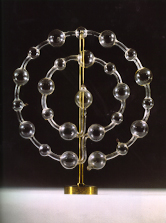
46.3 x 9.5 x 39.5
Glass and brass
CAT. 1878 : 523
Um tubo do comprimento de um metro, em forma de helice, com espheras no mesmo tubo espassadas, e cheio de gaz, para ser atravessado pela faisca electrica.
A one metre long tube, in the shape of a helix, with spheres at intervals along the tube, and filled with gas, to be crossed by the electrical spark.
Faraday ascertained that electrical discharges produced in a gaseous atmosphere have different colours, depending on the gas inside the glass receptacle. Air, oxygen and dry hydrogen chloride give a white light with a bluish tinge, chlorine gives a green light, and nitrogen a purple-blue light.
Experiments conducted in the 18th century with the electric egg, fulminating tubes, etc., led to the development of a new field of research which, during the 19th century, was crucial to the understanding of the structure of matter.
Geissler tubes, coming in a variety of shapes, played an important part in the observation of the different colours characteristic of electrical discharges in gases or low pressure vapours. These tubes have platinum electrodes at their ends and these communicate with the interior of the tube. Discharges are produced between the electrodes when connected to electrostatic machines, or supplied with power from Ruhmkorff coils.
Daguin, Pierre-Adolphe, Traité Élémentaire de Physique Théorique et Expérimentale, Paris, 1878, Vol. III, n.º 2260.